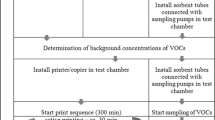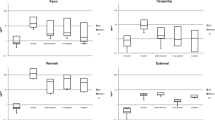Summary
The use of polychlorinated biphenyls (PCBs) is restricted to closed systems. They are thus still used as dielectric fluids in capacitors and transformers. The hypothesis that skin rashes and excema reported among datascreen operators might be caused by leakage of PCB from components in the screen terminals was investigated. No information about the chemical content of the electrical components in the actual datascreen terminals were available. The PCB-concentration in the atmosphere in a workplace where such skin reactions had previously occurred was therefore determined.
Air was sampled through 2 or 3 days, during work hours only. A glass fiber backed by an Amberlite XAD-2 column was used to trap the sample. The total level of PCBs in this sample was analysed by glass-capillary gas chromatography with electron capture detection. Commercial PCB mixtures were used as standards.
PCB-concentrations in the working atmosphere (56–81 ng/m3) were about 50–80 times the level of PCB in samples collected outside the building. Indoor and outdoor samples differed also qualitatively. The indoor samples contained only Aroclor 1242, while the outdoor samples contained a mixture of Aroclor 1242 and 1254.
The amounts of PCBs measured were below the safety level for working atmosphere, as recommended by NIOSH in 1977. However, knowing that the samples were collected in an office where there was no known use of PCBs, the levels found were unexpectedly high.
Further investigations should therefore be undertaken to clarify whether datascreen terminals might be sources of PCB-contamination.
Similar content being viewed by others

References
Jan J, Malnersic S, Faganeli J (1978) Chlorinated hydrocarbons (pesticides and polychlorinated biphenyls-PCBs) in the atmosphere of Ljubljana. Arh Hig Rada Toksikol 29:15–20
Lewis RG, Brown AR, Jackson MD (1977) Evaluation of polyurethane foam for sampling of pesticides, polychlorinated biphenyls and polychlorinated naphthalenes in ambient air. Anal Chem 49:1668–1672
Lindén V, Rolfsen S (1980) Occupational skin reactions among datascreen operators in Bergen. YHI Publication Oslo Norway. 29th Nordic Meeting on Occupational Health (in Norwegian), p 23
New Scientist (1980) A rash of hazards from computer screens, vol 18, p 761
Linden V, Rolfsen S (1981) Video computer terminals and occupational dermatitis (Letter to the editor). Scand J Work Environ Health 7:62–64
Nelson M (1972) Polychlorinated biphenyls — Environmental impact. A review by the panel on hazardous trace substances. Environ Res 5:249–362
Nicholson WJ, Moore JA (eds) (1979) Health effects of halogenated aromatic hydrocarbons. Ann NY Acad Sci 320:1–730
NIOSH (1977) Criteria for a recommended standard, occupational exposure to polychlorinated biphenyls (PCBs). US Department of Health Education and Welfare. NIOSH, Washington
Taylor JS (1979) Environmental chloracne: Update and overview. Ann NY Acad Sci 320: 295–307
WHO (1978) International Agency for Research on Cancer. IARC Monographs on the evaluation of the carcinogenic risk of chemicals to humans. Polychlorinated biphenyls and polybrominated biphenyls. WHO, Geneva, vol 18, p 56
Author information
Authors and Affiliations
Rights and permissions
About this article
Cite this article
Digernes, V., Astrup, E.G. Are datascreen terminals a source of increased PCB-concentrations in the working atmosphere?. Int. Arch Occup Environ Heath 49, 193–197 (1982). https://doi.org/10.1007/BF00377928
Received:
Accepted:
Issue Date:
DOI: https://doi.org/10.1007/BF00377928



